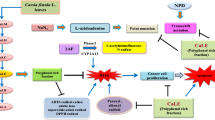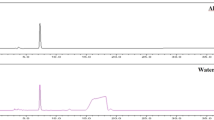Summary
In the present study, we report that the betel quid ingredient catechu, its extract and pure principle catechin were nonmutagenic in Salmonella typhimurium TA 100, TA 1535, TA 98, and TA 1538 assays with or without metabolic activation. They also exhibited dose-dependent decreases in mutagenicity of benzo(a)pyrene [B(a)P] and dimethylbenz(a)anthracene (DMBA) in strain TA 98 with metabolic activation. We further report that these compound inhibited activites of cytochrome P-450 and had no effect on glutathione S-transferase but increased the glutathione content in rat liver tissue. Simultaneous treatment of catechin prevented the mutagenic activity of B(a)P and DMBA metabolites in strain TA 98 in the absence of metabolic activation. Pre-and posttreatment of bacteria with catechin had no effect on the mutagenicity of B(a)P and DMBA metabolites. Catechin also inhibited the in vitro binding of 3H-B(a)P metabolites to calf thymus DNA. Catechu extract and catechin inhibited the nitrosation of methylurea by nitrite at pH 3.6 and 30°C. The formation of nitrosomethylurea in the reaction mixture was monitored by measuring the histidine revertants of strain TA 1535 in the absence of metabolic activation. Pre-and post-treatment of catechu extract or catechin had no effect on the mutagenicity of nitrosomethylurea in TA 1535. The nitrosation inhibition by catechin was through scavenging of nitrite observed at pH 3.6. The above study indicates that catechu in betel quid may act as an antimutagen and may suppress the mutagenic potential of other betel quid mutagens.
Similar content being viewed by others
References
Ames BN, Durston E, Yamasaki E, Lee FD (1973) Carcinogens are mutagens: a simple test system combining liver homogenate for activation and bacteria for detection. Proc Natl Acad Sci USA 70:2281–2285
Ames BN, McCann J, Yamasaki E (1975) Methods for detecting carcinogens and mutagens with salmonella/mammalian microsome mutagenicity. Mutat Res 31:347–364
Amonkar AJ, Nagabhushan M, D'Souza AV, Bhide SV (1986) Hydroxychavicol: a new phenolic antimutagen from betel leaf. Food Chem Toxicol 24:1321–1324
Bartsch H, O'Neil IK, Castegnaro M, Okada M, Davis W (eds) (1982) N-nitroso compounds: occurrence and biological effects. IARC Scientific Publication No. 41, International Agency For Research On Cancer, Lyon, pp 1–751
Burton K (1956) A study of conditions and mechanics of the diphenylamine reactions for the colorimetric estimation of deoxyribonucleic acid. Biochem J 62:315–323
Buty SG, Thompson S, Slaga TH (1976) The role of epidermal arylhydrocarbon hydroxylase in covalent binding of polycyclic hydrocarbon to DNA in its relationship to tumor initiation. Biochem Biophys Res Commun 70:1102–1108
Conn HO (ed) (1981) International workshop on (+)cyanidanol-3 in diseases of the liver. The Royal Society of Medicine, International Congress and symposium series, No. 7. Academic Press, London
Conney AH, Buering MK, Pantuck EJ, Pantuck CB, Fortner KE, Anderson KE, Kappas A (1980) Regulation of human drug metabolism by dietary factors. In: Environmental chemicals, enzyme function and human disease. Ciba Foundation, Symposium 76, Excerpta Medica, New York, pp 147–167
Eisenbrand G, Preussmann R (1970) Eine neve Methode zur kolorimetrischen Bestimmung von Nitrosaminen nach Spaltung der N-Nitroso-Gruppe mit Bromwasserstoff in Essig. Arzneim-Forsch (Drug Res) 20:1513–1517
Habig WH, Pabst MH, Jakboy WB (1974) The first enzymatic step in mercapturic acid III formation. J Biol Chem 49:7130–7139
Huang MT, Wood AM, Newmark HL, Sayer JM, Yagi M, Jerina DM, Conney AH (1983) Inhibition of mutagenicity by region diol epoxides of polycyclic aromatic hydrocarbons by phenolic plant flavonoids. Carcinogenesis 4:1631–1637
Maron MS, De Pierre JW, Mannervik B (1979) Levels of glutathione, glutathione reductase and gluthatione-S-transferase activities in rat lung and liver. Biochim Biophys Acta 582:67–78
Mehta FS, Gupta PC, Pindborg JJ (1981) Chewing and smoking habits in relation to precancer and oral cancer. J Cancer Res Clin Oncol 99:35–39
Nadkarni AK (1976) Indian Materia Medica, vol I, pp 11–13
Nagabhushan M, Amonkar AJ, D'Souza AV, Bhide SV (1987) Nonmutagenicity of betel leaf and its antimutagenic action against environmental mutagens. Neoplasma 34:159–168
Omura J, Sato R (1964) The carbon monoxide binding pigment of liver microsomes. Evidence for its hemoprotein nature. J Biol Chem 239:2370–2378
Rao AR (1984) Modifying influences of betel quid ingredients of B(a)P induced carcinogenesis in the buccal pouch of hamster. Int J Cancer 33:501–506
Rao AR, Singh A, Selvan S (1985) Inhibitory action of piper betel on the initiation of 7,12 dimethylbenz(a)-anthracene induced mammary carcinogenesis in mice. Cancer Lett 26:207–214
Sanghvi LD (1981) Cancer epidermiology: Indian scene. J Cancer Res Clin Oncol 99:1–14
Shah AS, Sarode AV, Bhide SV (1985) Experimental studies on mutagenic and carcinogenic effects of tobacco chewing. J Cancer Res Clin Oncol 109:203–207
Shirname LP, Menon MM, Nair J, Bhide SV (1983) Correlation of mutagenicity and tumorigenicity of betel quid and its ingredients. Nutr Cancer 5:87–91
Stich HF, Rosin MP, Bryson L (1982) The inhibitory effect of whole and deproteinized saliva on mutagenicity and clastogenicity resulting from a model nitrosation reaction. Mutat Res 9:283–292
Wattenberg LW (1972) Inhibition of carcinogenic and toxic effects of polycyclic hydrocarbons by phenolic antioxidants and ethoxyguin. J Natl Cancer Inst 48:1425–1430
Wattenberg LW, Coccia JB, Lam LKT (1980) Inhibitory effects of phenolic compounds on benzo(a)pyrene-induced neoplasia. Cancer Res 40:2820–2823
Author information
Authors and Affiliations
Rights and permissions
About this article
Cite this article
Nagabhushan, M., Amonkar, A.J., Nair, U.J. et al. Catechin as an antimutagen: its mode of action. J Cancer Res Clin Oncol 114, 177–182 (1988). https://doi.org/10.1007/BF00417833
Received:
Accepted:
Issue Date:
DOI: https://doi.org/10.1007/BF00417833




